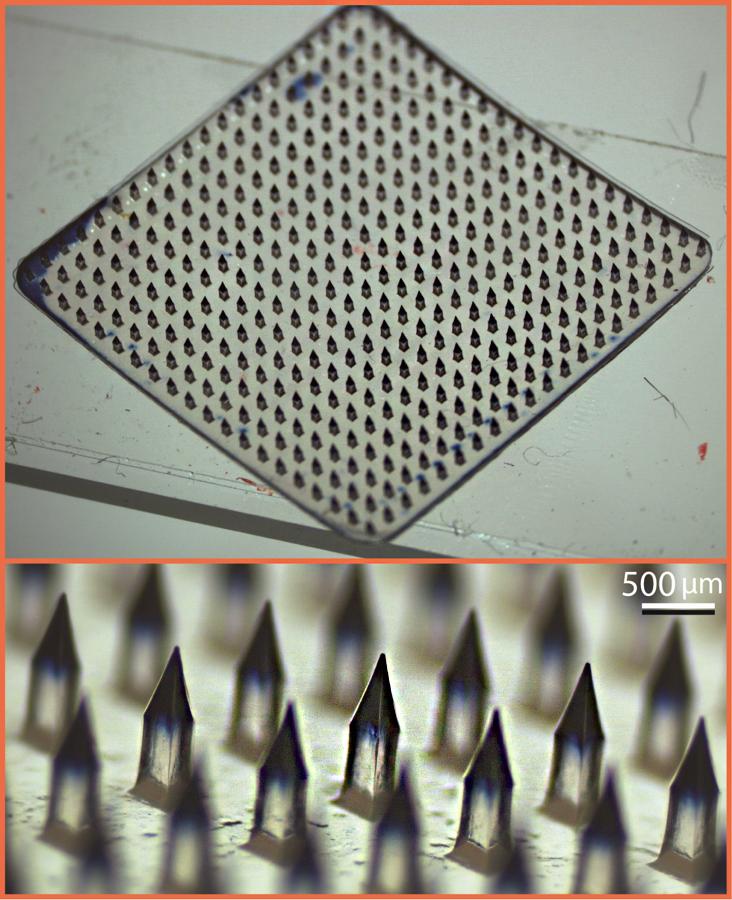An alternative to the syringe
Carnegie Mellon University will provide microneedle drug delivery patches to support COVID-19 vaccination and treatment research.
As health care professionals battle the COVID-19 pandemic on the front lines, engineers are working behind the scenes with innovative technologies to tip the scales in this global fight. Carnegie Mellon University’s Burak Ozdoganlar, who developed the manufacturing technique for dissolvable microneedle arrays, is offering to fabricate these patches for researchers working on potential vaccines and treatments.

Source: College of Engineering
Microneedle arrays contain hundreds of painless, dissolvable, tiny needles clustered on a miniature patch for delivery of vaccines or medications.
These are the same microneedle patches co-developed by Carnegie Mellon University and the University of Pittsburgh Medical Center and recently announced for use with the PittCoVacc vaccine.
“I’m seeking researchers who are working on a vaccine against, or treatment for, SARS-CoV-2 to collaborate with me,” said Ozdoganlar, a professor of mechanical engineering at Carnegie Mellon. “My lab can fabricate hundreds of microneedle arrays with your viable vaccine or antiviral drug very quickly for testing in your vaccine and drug development, and we can ramp up to thousands if needed.”
Once a viable vaccine is identified, we can provide the necessary expertise, experience, and connections to scale-up the manufacturing of the vaccine patches.
Burak Ozdoganlar, Professor, Mechanical Engineering
“Furthermore, once a viable vaccine is identified, we can provide the necessary expertise, experience, and connections to scale-up the manufacturing of the vaccine patches using Good Manufacturing Practice (GMP) guidelines to the levels that will effectively address the COVID-19 vaccination needs. We are here to do our part in providing support throughout this epidemic.”
Ozdoganlar has been developing and innovating microneedle array drug delivery devices since 2006.
Microneedle arrays contain hundreds of tiny needles clustered on a miniature patch about the size of a contact lens. The microneedles are made from biodissolvable sugar-like natural materials, and the vaccine or drug to be delivered is mixed with this water-soluble material when fabricating the microneedles. When applied onto the skin, the microneedles quickly dissolve and deliver the medication. Due to the small size of the needles, the microneedle patch causes no pain or bleeding.
While the arrays are being tested on humans to deliver chemotherapy as a treatment for skin cancer, they also hold strong potential for use in vaccination and other treatments.
The technology is particularly promising for delivering vaccines or antibodies to fight pathogens since abrasions to the skin—even very tiny ones—produce an immediate and powerful response from the immune system. Traditional syringe vaccines that enter muscle tissue do not elicit quite as effective a response; they require a much larger dose of vaccine than microneedles do to achieve the desired immunity or treatment. Therefore, vaccination and treatment through microneedle array patches can be significantly more effective and faster than using hypodermic needles.
Ozdoganlar is eager to help researchers worldwide who are working to fight the coronavirus. Potential collaborators should send inquiries to: ozdoganlar@cmu.edu.
Burak Ozdoganlar is the Ver Planck professor in mechanical engineering and the associate director of the Engineering Research Accelerator at Carnegie Mellon University. He holds courtesy appointments in biomedical engineering and materials science and engineering. He is a Fellow of the American Society of Mechanical Engineers (ASME).
